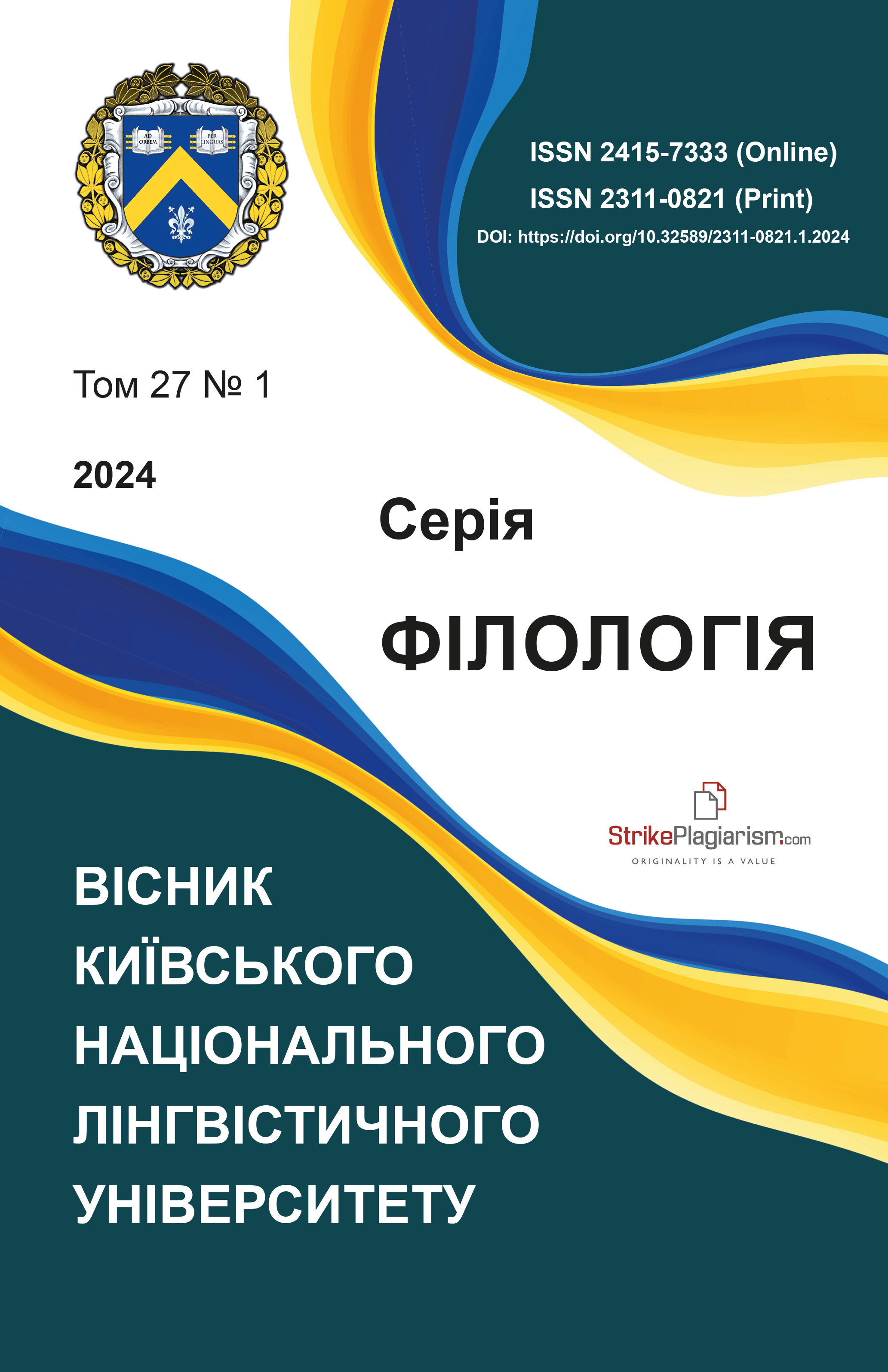Фонографічні та графостилістичні механізми творення лінгвістичного абсурду в постмодерністській прозі
DOI:
https://doi.org/10.32589/2311-0821.1.2024.309631Ключові слова:
мовний абсурд, варіант, графіка, графема, мовна гра, лінгвографія, фонема, постмодерністська художня література, семантика, порушенняАнотація
У статті досліджено фонографічні та графостилістичні механізми, які використовують постмодерністські автори для створення мовного абсурду в художній літературі. Аналіз зосереджено на порушеннях фонетичних і графічних норм від традиційних літературних конвенцій. На фонографічному рівні механізмами створення мовного абсурду є звуконаслідування, алітерація, асонанс, фонетична гра слів і фонетичні оказіоналізми. Такі прийоми спричиняють незвичні комбінації фонем, які контрастують із прийнятими стереотипними звуковими моделями. Це породжує какофонію дивних звуків, яка порушує милозвучність мови, створюючи ефект “одивнення”. Алітерацію й асонанс використовують для відтворення неприємних
звуків, яких зазвичай уникають у традиційних текстах як таких, що порушують естетичні норми. Фонетичні оказіоналізми відкривають перед читачем різноманітні палітри нових, незареєстрованих звукосполучень. Розглянуті графостилістичні механізми передбачають порушення графічних норм за допомогою таких прийомів, як: надмірна варіативність шрифтів, капіталізація та непунктуаційна організація тексту. Текстова візуалізація, що руйнує типові графічні конвенції, створюється за допомогою додаткових інтервалів між словами/рядками, нетрадиційного поділу на абзаци, вставлених фігурних ліній, убудованих фрагментів тексту в різних стилях. Спостерігається надмірне накопичення невербальної графіки – малюнків, діаграм, формул і символів з інших семіотичних систем. Орфографічні деформації (дублювання, переноси, авторські графони) також сприяють абсурдистському ефекту. Докладні приклади ілюструють, як накопичення цих фонографічних і графостилістичних відхилень породжує графічний хаос, що погіршує читабельність. Однак ця навмисна стратегія постмодерністських письменників спрямована на створення абсурдистського літературного досвіду, який відкидає конвенції і залучає читача до дослідження численних можливих інтерпретацій фрагментованого нетрадиційного тексту.
Посилання
Babelyuk, O. A. (2009). Pryntsypy postmodernistskoho tekstotvorennia suchasnoi
amerykanskoi prozy maloi formy: [monohrafiia]. Drohobych: TzOV “Vymir”, 296 s.
Babelyuk. O., Koliasa, O., & Smaglii, V. (2021). Language means of revealing postmodern
ludic absurd in English literary text. Wisdom. №. 4 (20). С. 166-179.
Bekhta, I. (2011). Paradyhma anhlomovnoho postmodernistskoho khudozhnoho tekstu.
Nauk. visn. Cherniv. un-tu: “Hermanska filolohiia”. Chernivtsi, Ser. 92. Vyp. 551/552.
S. 85.
Bieliekhova, L. I. (2004). Hlosarii z kohnityvnoi poetyky: naukovo-metodychnyi posibnyk.
Kherson: Ailant, 124 s.
Cammaerts, E. (2021). The poetry of nonsense. Hassell Street Press.
Dolitsky, M. S. (1994). Nonsense. The Encyclopedia of Language and Linguistics. L.:
Longman, P.2832 – 2833.
Koliasa, O. V. (2015). Stylistychni ta kohnityvno-semantychni mekhanizmy tvorennia
ihrovoho absurdu v anhlomovnomu fenteziinomu opovidanni: dys. Drohobytskyi
derzhavnyi pedahohichnyi universytet imeni Ivana Franka. Drohobych.
Koliasa, O. V. (2014). Mekhanizmy tvorennia ihrovoho absurdu v postmodernistskomu
khudozhnomu teksti. Naukovyi visnyk Drohobytskoho derzhavnoho pedahohichnoho
universytetu imeni Ivana Franka. Seriia: Filolohichni nauky (movoznavstvo) : [zb.
nauk. prats]. Drohobych, Vyp. 3. S. 107-115.
Kondratenko, N. V. (2012). Syntaksys ukrainskoho modernistskoho i postmodernistskoho
khudozhnoho dyskursu: monohrafiia. K.: Vydavn. dim Dmytra Buraho, 328 s.
Korotkova, L. V. (2001). Semantyko-kohnityvnyi ta funktsionalnyi aspekty tekstovykh
anomalii u suchasnii anhlomovnii khudozhnii prozi: Avtoref. dys. … kand. filol. nauk:
02.04. K., 20 s.
##submission.downloads##
Опубліковано
Номер
Розділ
Ліцензія
1. Дослідження, що публікуються у збірнику наукових праць, повинні бути виконані відповідно до чинного законодавства України та етичних норм. Основний обов’язок автора полягає в тому, щоб виконати таке дослідження, яке заслуговує на об’єктивне обговорення науковою спільнотою його значущості.
2. Автори повинні формулювати свої наукові спостереження у такий спосіб, щоб їхні результати могли бути підтверджені іншими вченими, без підробки отриманих висновків або маніпуляції ними.
3. Автори статей несуть відповідальність за зміст статей і за сам факт їх публікації.
4. Автор повинен цитувати ті публікації, які вплинули на сутність роботи, а також ті, які можуть швидко познайомити читача з попередніми роботами, важливими для розуміння цього дослідження. За винятком оглядів, слід мінімізувати цитування робіт, які не мають безпосереднього відношення до змісту дослідження. Автор зобов’язаний провести джерельний пошук, щоб знайти і процитувати оригінальні публікації, тісно пов’язані з цим матеріалом. Необхідно також коректно вказувати на джерела принципово важливих матеріалів, використаних у цій роботі, якщо вони не були отримані самим автором.
5. Автори повинні дотримуватися усіх чинних вимог щодо публікацій рукописів. Неприпустимим є плагіат та його удавання за оригінальну розвідку, а також подання до редакції раніше опублікованої статті. У випадках виявлення плагіату відповідальність несуть автори поданих матеріалів.
6. Експериментальне або теоретичне дослідження може іноді слугувати основою для науково коректної і об’єктивної критики роботи іншого дослідника. Опубліковані статті в окремих випадках можуть містити подібну критику. Персональна суб’єктивна критика не є доречною за жодних обставин.
7. Співавторами статті мають бути ті особи, науковий внесок яких є вагомим у її зміст та які розділяють відповідальність за здобуті результати. Автор, який подає рукопис до друку, відповідає за те, щоб до списку співавторів були включені всі ті й лише ті особи, які відповідають критеріям авторства. У статті, написаної декількома авторами, той з авторів, хто подає до редакції контактні відомості, документи і листується з редакторами, бере на себе відповідальність за згоду інших авторів статті на її публікацію у збірнику.
8. Автори повинні повідомити редактора про будь-який потенційний конфлікт інтересів, на які могла б вплинути публікація результатів, що містяться у рукописі.
9. Автори повинні чітко вказати джерела всієї процитованої інформації, оформити посилання на наукові джерела відповідно до вимог ДСТУ ГОСТ 7.1:2006.
10. Редколегія має право відмовити у публікації статті за умов недотримання зазначених вимог.
11. Автор може висловити побажання не залучати деяких рецензентів до розгляду рукопису. Проте головний редактор може прийняти рішення залучити одного або декількох із цих рецензентів, якщо переконаний, що їх думки є важливими для неупередженого розгляду рукопису. Таке рішення може бути прийняте, наприклад, у тому випадку, коли є серйозні суперечності між цим рукописом і попередньою роботою потенційного рецензента.
12. Запобігання псевдонауковим публікаціям є відповідальністю кожного автора, головного редактора, рецензента, видавця й організації.


